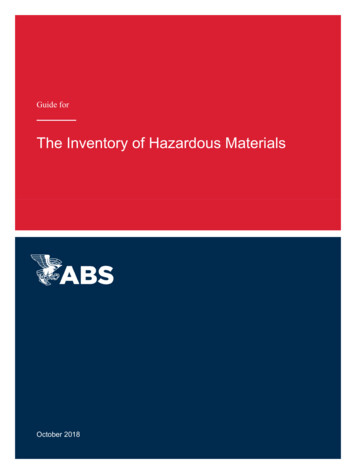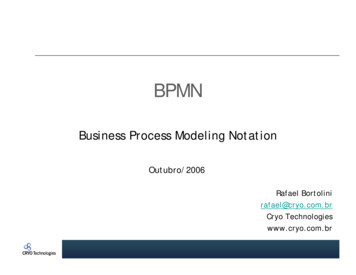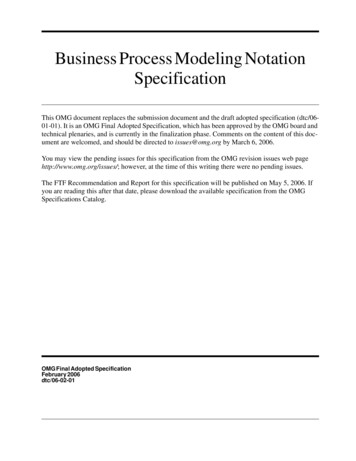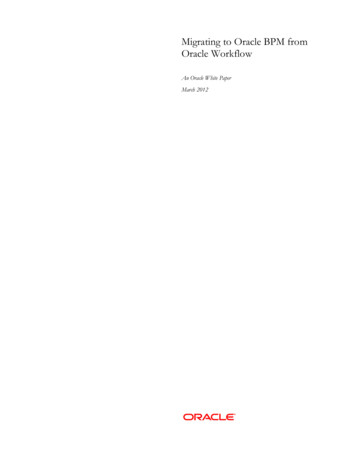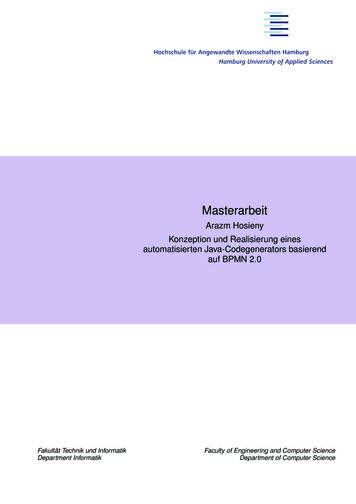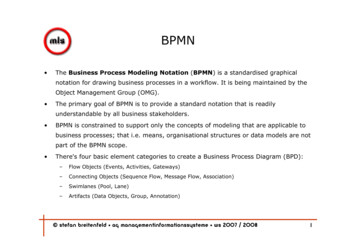
Transcription
BPMN The Business Process Modeling Notation (BPMN) is a standardised graphicalnotation for drawing business processes in a workflow. It is being maintained by theObject Management Group (OMG). The primary goal of BPMN is to provide a standard notation that is readilyunderstandable by all business stakeholders. BPMN is constrained to support only the concepts of modeling that are applicable tobusiness processes; that i.e. means, organisational structures or data models are notpart of the BPMN scope. There's four basic element categories to create a Business Process Diagram (BPD):–Flow Objects (Events, Activities, Gateways)–Connecting Objects (Sequence Flow, Message Flow, Association)–Swimlanes (Pool, Lane)–Artifacts (Data Objects, Group, Annotation) Stefan breitenfeld ag managementinformationssysteme ws 2007 / 20081
Excurs: Stakeholder A stakeholder is a person or organization that has a legitimate interest in a project orentity (this only appears in a business context). Stefan breitenfeld ag managementinformationssysteme ws 2007 / 20082
BPMN Core Elements Stefan breitenfeld ag managementinformationssysteme ws 2007 / 20083
BPMN Activities Stefan breitenfeld ag managementinformationssysteme ws 2007 / 20084
BPMN Events Stefan breitenfeld ag managementinformationssysteme ws 2007 / 20085
BPMN Gateways Stefan breitenfeld ag managementinformationssysteme ws 2007 / 20086
BPMN Connections Stefan breitenfeld ag managementinformationssysteme ws 2007 / 20087
BPMN Artifacts Stefan breitenfeld ag managementinformationssysteme ws 2007 / 20088
BPMN Swimlanes Stefan breitenfeld ag managementinformationssysteme ws 2007 / 20089
Example I – Normal Flow Stefan breitenfeld ag managementinformationssysteme ws 2007 / 200810
Example II – Discussion Cycle Stefan breitenfeld ag managementinformationssysteme ws 2007 / 200811
Example III – Collect Votes Stefan breitenfeld ag managementinformationssysteme ws 2007 / 200812
BPMN Process Types private processes abstract processes collaboration processes Stefan breitenfeld ag managementinformationssysteme ws 2007 / 200813
Private Processes Private (internal) business processes– Private business processes are those internal to a specific organization and arethe type of processes that have been generally called workflow or BPMprocesses. If swim lanes are used then a private business process will becontained within a single Pool. The Sequence Flow of the Process is thereforecontained within the Pool and cannot cross the boundaries of the Pool. MessageFlow can cross the Pool boundary to show the interactions that exist betweenseparate private business processes. Stefan breitenfeld ag managementinformationssysteme ws 2007 / 200814
Abstract Processes Abstract (public) processes– These represent the interactions between a private business process and anotherprocess or participant. Only those activities that communicate outside the privatebusiness process are included in the abstract process. All other “internal”activities of the private business process are not shown in the abstract process.Thus, the abstract process shows to the outside world the sequence of messagesthat are required to interact with that business process. Abstract processes arecontained within a Pool and can be modeled separately or within a larger BPMNdiagram to show the Message Flow between the abstract process activities andother entities. Stefan breitenfeld ag managementinformationssysteme ws 2007 / 200815
Collaboration Processes Collaboration (global) processes– A collaboration process depicts the interactions between two or more businessentities. These interactions are defined as a sequence of activities that representthe message exchange patterns between the entities involved. Collaborationprocesses may be contained within a Pool and the different participant businessinteractions are shown as Lanes within the Pool. They may also be shown as twoor more Abstract Processes interacting through Message Flow (as described inthe previous section). These processes can be modeled separately or within alarger BPMN Diagram to show the Associations between the collaborationprocess activities and other entities. Stefan breitenfeld ag managementinformationssysteme ws 2007 / 200816
ARIS BPMN offers all elements and content being part of BPMN converts BPMN - EPK / backwards (if allowed) and checks semantics Stefan breitenfeld ag managementinformationssysteme ws 2007 / 200817
Resources Object Management Group – Business Process Management Initiative– http://bpmn.org/ BPMN Supporters– http://bpmn.org/BPMN Supporters.htm BPMN 1.0 OMG Specification– BPMN%2010%20Spec%2006-02-01.pdf BPMN Introduction, Survey & Training Kit– http://www.diveintobpm.org/ Stefan breitenfeld ag managementinformationssysteme ws 2007 / 200818
Tools Intalio Business Process Management Suite (Eclipse-based)– http://bpms.intalio.com/index.php Soyatec eBPMN (Eclipse-based)– http://www.soyatec.com/ebpmn/features.html Eclipse STP BPMN Modeler– http://www.eclipse.org/stp/bpmn/ Stefan breitenfeld ag managementinformationssysteme ws 2007 / 200819
BPEL The Business Process Execution Language (BPEL) is an executivebusiness process modeling language. It is serialised via XML and describesprocesses whose activities are implemented through web services. BPEL cannot interact directly with human resources, but only with webservices, which then can take the part of interfaces to humans. The initiators are Microsoft, IBM and BEA. BPEL itself doesn't describe a way for graphical illustrations of businessprocesses; this is part of BPMN. BPEL was designed for "Programming in the Large".What's that? Stefan breitenfeld ag managementinformationssysteme ws 2007 / 200820
Executable vs. Abstract Processes executable processes– can be deployed on a workflow engine and then be run abstract processes– are views on executable processes, to describe the latter ones (so-calledbehavioral interfaces)– are used to hide the details of a process from e.g. business partners Stefan breitenfeld ag managementinformationssysteme ws 2007 / 200821
BPEL4People / Subprocesses BPEL4People– IBM and SAP created an initiative called BPEL4People to collect specifications forinteraction with humans. So far only a whitepaper exists. WS-BPEL 2.0 Extension for Subprocesses– BPEL doesn't know subprocesses. This results in difficulties, as BPEL's notintended to terminate a subprocess when the main one gets terminated. Suchfunctionality has to be implemented by a further specific web service (which thenis not part of the BPEL standard).– Once again IBM and SAP introduced a whitepaper named "WS-BPEL 2.0Extension for Subprocesses" that explains an extension for subprocesses withinBPEL. Stefan breitenfeld ag managementinformationssysteme ws 2007 / 200822
BPEL – Elements (I) receive / reply – Warten auf Nachricht ( receive ) und Antwort auf eine Nachricht ( reply ). DieKombination beider Aktivitäten ermöglicht eine request - response Operation füreinen WSDL portType des Prozesses. invoke – Aufruf eines Web Services. assign – Updaten von Variablen mit neuen Daten. throw / catch – Interne Fehler eines Geschäftsprozesses signalisieren (throw) bzw. abfangen(catch). terminate – Explizites Beenden des Prozesses. Stefan breitenfeld ag managementinformationssysteme ws 2007 / 200823
BPEL – Elements (II) wait – Der Prozess wartet eine definierte Zeit. empty – Leere Aktivität - wird verwendet, um Fehler abzufangen oder um Aktivitäteneines Geschäftsprozesses zu synchronisieren. sequence – Sequentielle Ausführung der nachgereihten Aktivitäten. switch – Aktivität zur Modellierung von Verzweigungen. Kann eine oder mehrereBedingungen ( case condition "boolscher Ausdruck" ) und optional einenalternativen Zweig ( otherwise ) enthalten. Stefan breitenfeld ag managementinformationssysteme ws 2007 / 200824
BPEL – Elements (III) while – Mittels while wird die betroffene Aktivität so lange wiederholt ausgeführt, bisder boolesche Ausdruck nicht mehr erfüllt wird. pick – Diese Aktivität wartet auf das Auftreten eines Ereignisses aus einer Menge vonEreignissen und führt danach die entsprechend angeführte Aktivtät aus. flow – Das flow Konstrukt ermöglicht die parallele Verarbeitung von einer odermehreren Aktivitäten. Mittels des link - Konstruktes können direkt oderindirekt eingebettete Aktivitäten synchronisiert werden. Stefan breitenfeld ag managementinformationssysteme ws 2007 / 200825
BPEL – Elements (IV) scope – Das scope - Konstrukt ermöglicht die Verbindung einer eingebetteten Aktionmit Variablen, einer Fehler- und Kompensationsbehandlung. Zur Koordinationwird hierbei das BusinessAgreement Protokoll der WS-Transaction Specifikationverwendet. compensate – compensate wird verwendet, wenn eine in einen scope eingebetteteAktion erfolgreich durchgeführt wurde, diese Aktion aber kompensiert werdenmuss. Dieses Konstrukt kann nur von einem anderen compensation handler odervom fault handling aufgerufen werden. Stefan breitenfeld ag managementinformationssysteme ws 2007 / 200826
Resources WS BPEL 2.0 Specification– .0-OS.html Advanced BPEL – Oracle SOA Best Practices– http://www.oracle.com/technology/pub/articles/bpel cookbook/index.html Pattern-based Evaluation of Oracle BPEL– cle BPEL v.10.1.2.pdf Article: BPEL & Java– ss?l BPELJava Dumas, M.; van der Aalst, W.M.P., ter Hofstede, A.H.M. (editors):Process-Aware Information Systems: Bridging People and SoftwareThrough Process Technology. Wiley and Sons, 2005. Stefan breitenfeld ag managementinformationssysteme ws 2007 / 200827
Tools Active BPEL Open Source Engine– -overview.htm NetBeans Enterprise Pack with BPEL Support– http://www.netbeans.org/products/enterprise/ Apache ODE (Orchestration Director Engine)– http://ode.apache.org/ Queensland University of Technology – Translators (BPMN to BPEL, BPMNto Petri Nets, BPEL to Petri Nets)– / Stefan breitenfeld ag managementinformationssysteme ws 2007 / 200828
The Business Process Modeling Notation(BPMN) is a standardised graphical notation for drawing business processes in a workflow. It is being maintained by the Object Management Group (OMG). The primary goal of BPMN is to provide a standard notation that is readily understandable by all business stakeholders.





